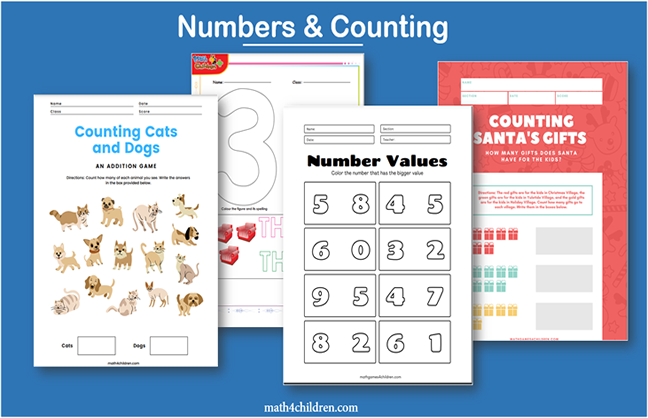![]()
Counting Board
Counting boards are educational tools used to teach and reinforce mathematical concepts in a tactile and visual manner. These boards typically consist of a frame with rows and columns, along with movable beads or markers that can be manipulated to represent numbers and perform calculations.
- Number 1 worksheet for preschool
- Missing numbers for kindergarten
- Counting pictures for kindergarten
- Numbers 1 to 5 worksheets for kindergarten
- Skip counting in twos kindergarten worksheet
- Complete number patterns missing a number up to ten
- Color and count numbers to ten worksheet
- Counting cars, planes and more worksheet
- Counting to 100 and finding missing numbers sheet
- Number lines with missing numbers pdf
- Number lines with missing numbers 10 to 20
- Number lines with missing numbers 20 to 30
- Number lines with missing numbers 30 to 40

History of Counting Boards
Counting boards have a rich history dating back to ancient civilizations such as the Mesopotamians and Egyptians. The earliest forms were simple designs etched into clay or stone, evolving over time into more elaborate wooden structures used in medieval Europe.
Components of a Counting Board
A typical counting board comprises a sturdy frame with evenly spaced rows and columns. The frame holds rows of beads or markers that can be shifted horizontally or vertically to represent different numerical values.
Types of Counting Boards
There are two main types of counting boards: traditional and modern digital versions. Traditional counting boards are tactile and physical, while digital boards utilize electronic displays and interactive features.
Benefits of Using Counting Boards
Counting boards offer numerous benefits, including enhancing mathematical comprehension, promoting hands-on learning, and catering to diverse learning styles. They also aid in developing fine motor skills and spatial reasoning.
How to Use a Counting Board
Using a counting board is simple yet effective. Beginners can start with basic counting exercises, while advanced users can explore more complex mathematical operations such as addition, subtraction, multiplication, and division.
Counting Boards in Education
Counting boards are widely used in educational settings to support the teaching of mathematics. They can be found in classrooms, resource centers, and homeschooling environments, catering to learners of all ages and abilities.
Counting Boards in Special Education
In special education, counting boards play a vital role in accommodating diverse learning needs. They provide a multisensory approach to mathematics, allowing students with disabilities to actively engage in learning and problem-solving.
Counting Boards in Business
Beyond education, counting boards have practical applications in various industries. In business settings, they are utilized for accounting purposes, inventory management, and financial analysis, offering a visual representation of numerical data.
DIY Counting Boards
For those interested in creating their own counting boards, DIY options are readily available. With basic materials such as wood, beads, and paint, individuals can construct custom boards tailored to their specific preferences and requirements.
Tips for Choosing a Counting Board
When selecting a counting board, it's essential to consider factors such as durability, size, and features. Educators should look for boards that align with their curriculum goals, while parents may prioritize safety and ease of use.
Maintenance and Care of Counting Boards
Proper maintenance of counting boards ensures longevity and optimal performance. Regular cleaning and storage in a dry, temperate environment can prevent damage and preserve the integrity of the board over time.
Innovations in Counting Boards
Recent innovations in counting boards have introduced technological enhancements such as interactive displays, audio feedback, and connectivity options. These advancements aim to enhance user engagement and expand the capabilities of traditional counting tools.
Future Trends in Counting Boards
Looking ahead, the future of counting boards holds promise for further innovation and integration into various fields. With advancements in technology and educational pedagogy, counting boards will continue to evolve to meet the changing needs of learners worldwide.
Conclusion
Counting boards are invaluable tools for teaching and learning mathematics, offering a hands-on approach that fosters comprehension and engagement. Whether in the classroom, at home, or in professional settings, these versatile tools play a vital role in numerical literacy and problem-solving skills development.
FAQs (Frequently Asked Questions)
-
Can counting boards be used for children with special needs?
- Yes, counting boards are highly adaptable and can be modified to accommodate different learning styles and abilities.
-
Are there digital versions of counting boards available?
- Yes, modern counting boards often feature digital displays and interactive features for enhanced learning experiences.
-
What age group is suitable for using counting boards?
- Counting boards can be introduced to children as young as preschool age and continue to be beneficial throughout adulthood.
-
How do counting boards differ from other math manipulatives?
- Counting boards offer a visual representation of numerical concepts, allowing users to physically manipulate beads or markers to perform calculations.
-
Can counting boards be customized for specific educational purposes?
- Yes, counting boards can be tailored to align with curriculum objectives and individual learning goals, making them versatile tools for educators and learners alike.
https://www.youtube.com/watch?v=S33beiOAm_M
- Yes, counting boards can be tailored to align with curriculum objectives and individual learning goals, making them versatile tools for educators and learners alike.
